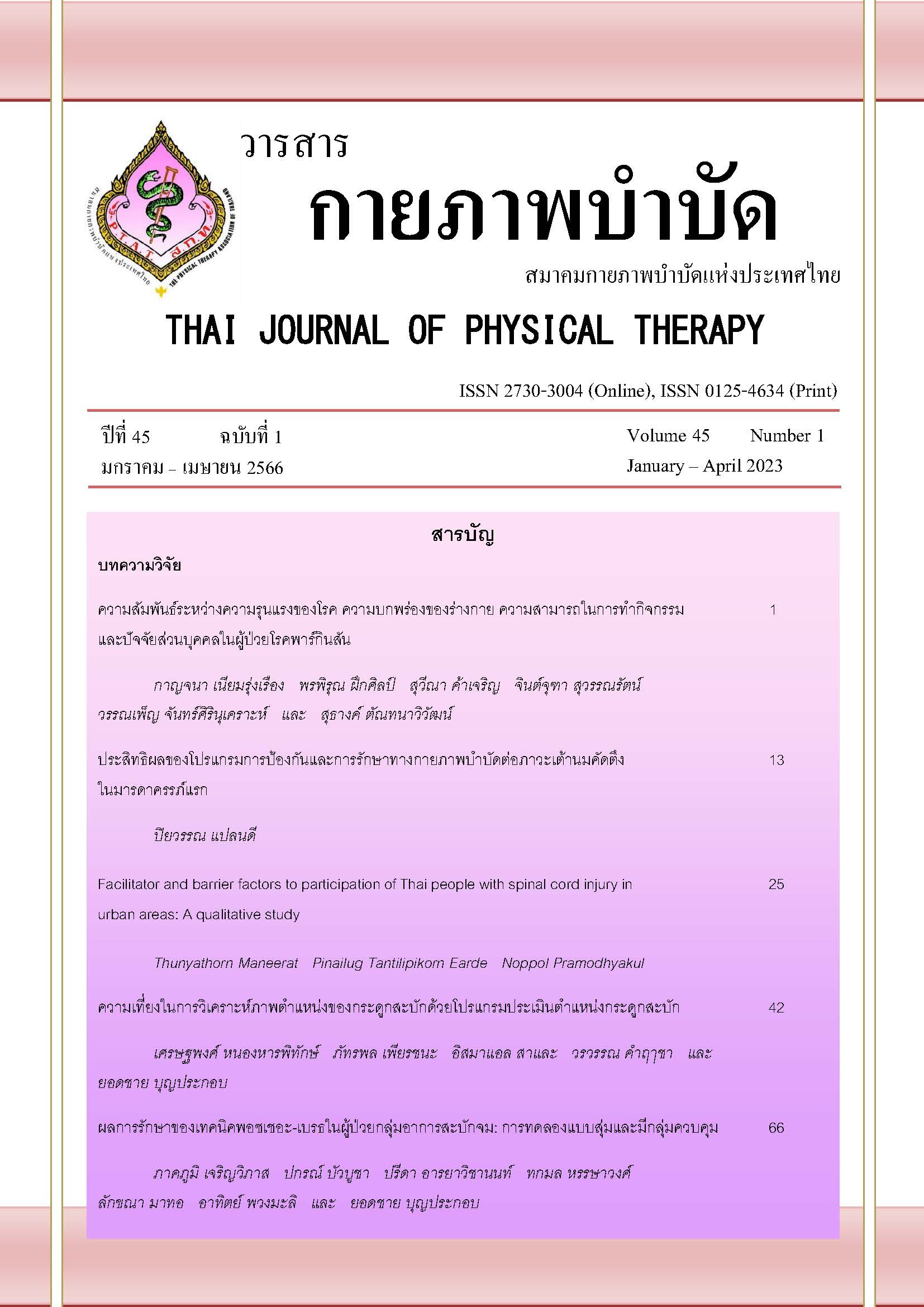ประสิทธิผลของโปรแกรมการป้องกันและการรักษาทางกายภาพบำบัดต่อภาวะเต้านมคัดตึงในมารดาครรภ์แรก
Main Article Content
บทคัดย่อ
ที่มาและความสำคัญ: ภาวะเต้านมคัดตึงเป็นปัจจัยหนึ่งที่ทำให้ความสำเร็จในการเลี้ยงลูกด้วยนมแม่ของประเทศไทยยังไม่บรรลุตามเป้าหมาย ดังนั้น ควรเตรียมความพร้อมการเลี้ยงลูกด้วยนมแม่ตั้งแต่ระยะตั้งครรภ์และการป้องกันภาวะเต้านมคัดตึงระหว่างการให้นมลูก โดยเฉพาะในมารดาครรภ์แรก
วัตถุประสงค์: เพื่อศึกษาประสิทธิผลของโปรแกรมการป้องกันและการรักษาภาวะเต้านมคัดตึงด้วยวิธีทางกายภาพบำบัดต่อการไหลของน้ำนมในมารดาครรภ์แรก
วิธีการวิจัย: กลุ่มตัวอย่างเป็นมารดาครรภ์แรกที่มารับบริการฝากครรภ์ คลอดบุตรและพักฟื้นหลังคลอด ที่โรงพยาบาลชุมพวง จำนวน 18 ราย แบ่งออกเป็นกลุ่มควบคุมที่ได้รับการพยาบาลตามปกติ 9 ราย และกลุ่มทดลองที่ได้รับโปรแกรมการป้องกันภาวะเต้านมคัดตึง 9 ราย หลังคลอดบุตรประเมินการไหลของน้ำนมเพื่อเข้าสู่โปรแกรมการรักษา หากมีภาวะเต้านมคัดตึง วิเคราะห์ข้อมูลด้วยสถิติ chi-square test, independent t-test, Kruskal Wallis Test และ paired t-test
ผลการวิจัย: พบว่า กลุ่มทดลองมีคะแนนเฉลี่ยการไหลของน้ำนมหลังคลอดในชั่วโมงที่ 12, 24, และ 48 สูงกว่ากลุ่มควบคุม เมื่อเปรียบเทียบผลหลังการรักษาภาวะเต้านมคัดตึง มีคะแนนเฉลี่ยการไหลของน้ำนมเพิ่มขึ้นอย่างมีนัยสำคัญทางสถิติ (p<0.05)
สรุปผล: โปรแกรมทางกายภาพบำบัดในการป้องกันและการรักษาภาวะเต้านมคัดตึงช่วยให้การไหลของน้ำนมในมารดาครรภ์แรกเพิ่มมากขึ้น
Article Details

อนุญาตภายใต้เงื่อนไข Creative Commons Attribution-NonCommercial-NoDerivatives 4.0 International License.
เอกสารอ้างอิง
Ballard O, Morrow AL. Human milk composition: nutrients and bioactive factors. Pediatr Clin North Am. 2013; 60(1): 49-74.
Rollins NC, Bhandari N, Hajeebhoy N, Horton S, Lutter CK, Martines JC, et al. Why invest, and what it will take to improve breastfeeding practices. Lancet. 2016; 387(10017): 491-504.
Lawrence RA, Lawrence RM. Breastfeeding: a guide for the medical profession. 6 ed. Philadelphia, Elsevier Mosby, 1999.
Victora CG, Bahl R, Barros AJ, França GV, Horton S, Krasevec J, et al. Breastfeeding in the 21st century: epidemiology, mechanisms, and lifelong effect. Lancet. 2016; 387(10017): 475-90.
Winichagoon P, Damrongwongsiri O. Breastfeeding situation, facilitators and obstacles, policy and program to promote breastfeeding in Thailand. J Nutr Assoc Thailand. 2020; 55(1): 66-81. (in Thai)
Cetthkrikul N, Topothai C, Topothai T, Pongutta S, Kunpeuk W, Prakongsai P, et.al. Situation of breastfeeding among mothers receiving services in public hospitals in Thailand, J Health Res. 2016; 25(4): 657-63.(in Thai)
Giugliani ER. Problem as comuns na lactação e seu manejo [Common problems during lactation and their management]. J Pediatr (Rio J). 2004; 80(5): 147-54.
Sakha K. Behbahan AGG. The onset time of lactation after delivery. JIRI 2005; 19(2): 135-9.
Leung SS. Breast pain in lactating mothers. Hong Kong Med J. 2016; 22(4): 341-6.
Jacobs A, Abou-Dakn M, Becker K, Both D, Gatermann S, Gresens R, et al. S3-Guidelines for the treatment of Inflammatory breast disease during the lactation period. Geburtshilfe Frauenheilkd. 2013; 73(12): 1202-8.Campbell SH. Recurrent plugged ducts. J Hum Lact. 2006; 22(3): 340-3.
Campbell SH. Recurrent plugged ducts. J Hum Lact. 2006; 22(3): 340-3.
Lemeshow S, Hosmer DW, Klar J, Lwanga SK. World Health Organization. Adequacy of sample size in health studies. Chichester: Wiley, 1990.
Trainapakul C, Chaiyawattana M, Kanavitoon W, Tiumtaogerd R, Naka S, Mitrniyodom W, et. al. Effect of milk ejection performance of postpartum mother after breasts massage and compression with mini hot bag and herbal compress.J Nurs Educ. 2010; 3(3): 75-91. (in Thai)
Masae M, Kala S, Chatchawet W. Effect of Self-Breast Massage Program on Milk Ejection of First-Time Mothers. Pnu Sci J. 2019;11(3):1-14. (in Thai)
Pakdeechot S, Morarad R, Sakontarat P. The effect of increasing milk production program on secretion time of colostrum in postpartum mothers. J Health Res. 2017; 19(2): 279-87. (in Thai)
Nuampa S, Tangsuksan P, Jitima V, Nguycharoen G. Breast massage for breastfeeding promotion and problem solving. Nurs Sci J Thai. 2020; 38(3): 4-21. (in Thai)
Witt AM, Bolman M, Kredit S, Vanic A. Therapeutic breast massage in lactation for the management of engorgement, plugged ducts, and mastitis. J Hum Lact. 2016; 32(1): 123-31.
Topothai C, Topothai T, Suphanchaimat R, Patcharanarumol W, Putthasri W, Hangchaowanich Y, et. al. Breastfeeding practice and association between characteristics and experiences of mothers living in Bangkok. Int J Environ Res Public Health. 2021; 18(15): 7889.
Thussanasupap B, Lapvongwatana P, Kalampakorn S, Spatz DL. Effects of the community-based breastfeeding promotion program for working mothers. PRIJNR. 2016; 20(3): 196-209.
Kent JC, Prime DK, Garbin CP. Principles for maintaining or increasing breast milk production. J Obstet Gynecol Neonatal Nurs. 2012; 41(1): 114-21.
Kanhadilok S, McCain NL, McGrath JM, Jallo N, Price SK, Chiaranai C. Factors associated with exclusive breastfeeding through four weeks postpartum in Thai adolescent mothers. J Perinat Educ. 2016; 25(3): 150-61.
Shellshear M. Therapeutic ultrasound in post-partum breast engorgement. Aust J Physiother. 1981; 27(1): 15-6.
McLachlan Z, Milne EJ, Lumley J, Walker BL. Ultrasound treatment for breast engorgement. Aust J Physiother. 1991; 37(1): 23-8.
Cooper BB, Kowalsky DS. Physical therapy intervention for treatment of blocked milk ducts in lactating women. J Womens Health Phys Therap. 2015; 39(3): 115-26.
Lavigne V, Gleberzon BJ. Ultrasound as a treatment of mammary blocked duct among 25 postpartum lactating women. J Chiropr Med. 2012; 11(3): 170-8.


